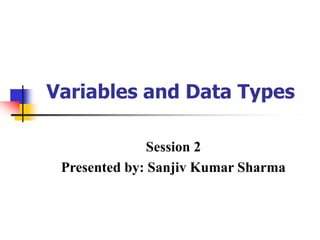work.ppt it describes about programming fundamentals
•Download as PPT, PDF•
0 likes•1 view
Programming Fundamentals of programming language
Report
Share
Report
Share

Recommended
Recommended
More Related Content
Similar to work.ppt it describes about programming fundamentals
Similar to work.ppt it describes about programming fundamentals (20)
Recently uploaded
Recently uploaded (20)
FDO for Camera, Sensor and Networking Device – Commercial Solutions from VinC...

FDO for Camera, Sensor and Networking Device – Commercial Solutions from VinC...
Introduction to FDO and How It works Applications _ Richard at FIDO Alliance.pdf

Introduction to FDO and How It works Applications _ Richard at FIDO Alliance.pdf
How Red Hat Uses FDO in Device Lifecycle _ Costin and Vitaliy at Red Hat.pdf

How Red Hat Uses FDO in Device Lifecycle _ Costin and Vitaliy at Red Hat.pdf
Where to Learn More About FDO _ Richard at FIDO Alliance.pdf

Where to Learn More About FDO _ Richard at FIDO Alliance.pdf
Integrating Telephony Systems with Salesforce: Insights and Considerations, B...

Integrating Telephony Systems with Salesforce: Insights and Considerations, B...
Behind the Scenes From the Manager's Chair: Decoding the Secrets of Successfu...

Behind the Scenes From the Manager's Chair: Decoding the Secrets of Successfu...
10 Differences between Sales Cloud and CPQ, Blanka Doktorová

10 Differences between Sales Cloud and CPQ, Blanka Doktorová
SOQL 201 for Admins & Developers: Slice & Dice Your Org’s Data With Aggregate...

SOQL 201 for Admins & Developers: Slice & Dice Your Org’s Data With Aggregate...
Optimizing NoSQL Performance Through Observability

Optimizing NoSQL Performance Through Observability
Measures in SQL (a talk at SF Distributed Systems meetup, 2024-05-22)

Measures in SQL (a talk at SF Distributed Systems meetup, 2024-05-22)
work.ppt it describes about programming fundamentals
- 1. Variables and Data Types Session 2 Presented by: Sanjiv Kumar Sharma
- 2. Elementary Programming with C/Session 2/ 2 of 22 Objectives Discuss variables Differentiate between variables and constants List the different data types and make use of them in C programs Discuss arithmetic operators
- 3. Elementary Programming with C/Session 2/ 3 of 22 Variables Data Memory Each location in the memory is unique Variables allow to provide a meaningful name for the location in memory 15 Data in memory 15
- 4. Elementary Programming with C/Session 2/ 4 of 22 Example A, B and C are variables in the pseudocode BEGIN DISPlAY ‘Enter 2 numbers’ INPUT A, B C = A + B DISPLAY C END Variable names takes away the need for a programmer to access memory locations using their address The operating system takes care of allocating space for the variables To refer to the value in the memory space, we need to only use the variable name
- 5. Elementary Programming with C/Session 2/ 5 of 22 The names of variables, functions, labels, and various other user defined objects are called identifiers Some correct identifier names arena s_count marks40 class_one Examples of erroneous identifiers 1sttest oh!god start... end Identifiers can be of any convenient length, but the number of characters in a variable that are recognized by a compiler varies from compiler to compiler Identifiers in C are case sensitive Identifier Names ! is invalid
- 6. Elementary Programming with C/Session 2/ 6 of 22 Keywords Keywords : All languages reserve certain words for their internal use Keywords hold a special meaning within the context of the particular language No problem of conflict as long as the keyword and the variable name can be distinguished. For example, having integer as a variable name is perfectly valid even though it contains the keyword int
- 7. Elementary Programming with C/Session 2/ 7 of 22
- 8. Elementary Programming with C/Session 2/ 8 of 22 void char double Basic Data Types The basic data types are float int
- 9. Elementary Programming with C/Session 2/ 9 of 22 Type float Stores values containing decimal places float num; Precision of upto 6 digits 32 bits (4 bytes) of memory Examples: 23.05, 56.5, 32
- 10. Elementary Programming with C/Session 2/ 10 of 22 Type char Stores a single character of information char gender; gender='M'; 8 bits (1 byte) of memory Examples: ‘a’, ‘m’, ‘$’ ‘%’ , ‘1’, ’5’
- 11. Elementary Programming with C/Session 2/ 11 of 22 Type void Stores nothing Indicates the compiler that there is nothing to expect
- 12. Elementary Programming with C/Session 2/ 12 of 22 Derived Data Types int short short int (Occupies less memory space than int) Derived data type Basic Data types Data type Modifiers int unsigned int (Permits only positive numbers) unsigned int/double Long int /longdouble (Occupies more space than int/double) long
- 13. Elementary Programming with C/Session 2/ 13 of 22 long and short Types short int occupies 8 bits (1 byte) allows numbers in the range -128 to 127 long int occupies 32 bits (4 bytes) 2,147,483,647 and 2,147,483,647 long double occupies 128 bits (16 bytes)
- 14. Elementary Programming with C/Session 2/ 14 of 22 Data Types and their range-2 Type Approximate Size in Bits Minimal Range signed short int 8 Same as short int signed short int 8 Same as short int long int 32 -2,147,483,647 to 2,147,483,647 signed long int 32 0 to 4,294,967,295 unsigned long int 32 0 to 4,294,967,295 float 32 Six digits of precision double 64 Ten digits of precision long double 128 Ten digits of precision
- 15. Thank You Elementary Programming with C/Session 2/ 15 of 22